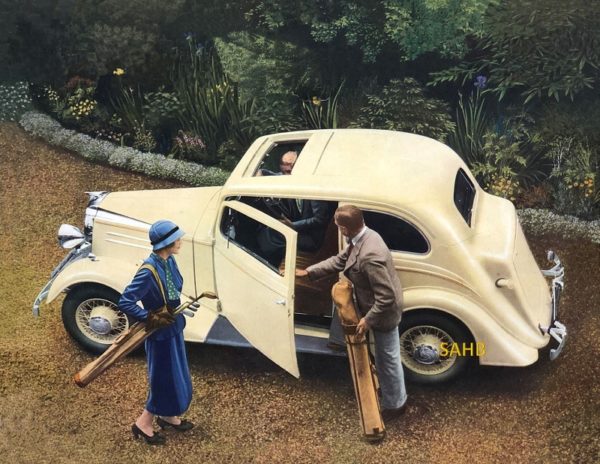
Golfers, dressed in the latest fashions. The gravelled drive and beautifully tended borders of what must be a substantial house. A stylish, lightly streamlined car in a bright colour. Surely this must be the image of patrician good taste that Vauxhall wants to present. Not quite…
Vauxhall up to 1925 made fine sporting cars of impeccable pedigree, the 30-98 rivalling and, in the opinion of many, surpassing the 3-litre Bentley. But they found it increasingly difficult to make profits in the years after the Great War and sought a major partner. On 16 November 1925 Vauxhall was bought by General Motors. Senior US executives in GM were not impressed: Vauxhall were making no more than seventeen cars a week and their finances were a disaster. The company was moved firmly into the middle market, with the introduction in 1930 of the low-cost two-litre Vauxhall Cadet – retailing at £280. It was, nevertheless, the first British car with a synchromesh gearbox – so General Motors were clearly aiming to increase production volumes by using their massive engineering, design and production resources to offer modern technology and high equipment levels at a reasonable price.
Their strategy only really started to pay off 1933 with the launch of the AS-type Light Six, with its all-steel body and a modern overhead-valve six-cylinder engine. It was offered in 12HP and 14HP versions, and the four-door saloon was joined, at extra cost, by a two-door saloon, coupé, tourer and cabriolet.
The Light Six was great success, with 26,000 examples being sold in just over 12 months and with 24-hour shift work at the Luton factory to meet demand. Vauxhall at last became a significant competitor in the British market.
More was to come. In 1935 the AS-type Light Six was replaced by the D-type Light Six, with a major change: the addition of GM’s patented Dubonnet suspension, making it the first mass-production British saloon car with independent front springing.
Our Snapshot shows the 1936 two-door coupé D-type Light Six, fitted as standard with a Pytchley sliding roof and ‘Vauxhall No-Draught Ventilation’ (the front quarter-lights just visible in our picture). It was priced at a remarkably competitive £245 (not much more than the £205 asked for the standard, rather more prosaic, standard saloon and £225 for the de-luxe saloon). The brochure waxed lyrical on the quality of the car, employing many diagrams and photographs to explain the advantages of independent front suspension and the ventilation system. One advantage of the continuing use of a separate chassis was the range of special bodies also offered, from Tickford coupés to Wingham cabriolets. No such possibility was available on the next Vauxhall to be introduced, the smaller 10-4 of 1937. This was the first mass-production British unibody saloon car – but the D-type continued with its wide range of possible coachwork until it was replaced by the unibody 14-6 in 1938.
Photo courtesy of The Richard Roberts Archive.







Leave a Comment